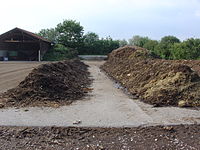
Photo from wikipedia
Abstract Due to the high water- and nutrient-use efficiency, hydroponic cultivation is increasingly vital in progressing to environment-friendly food production. To further alleviate the environmental impacts of synthetic fertilizer production,… Click to show full abstract
Abstract Due to the high water- and nutrient-use efficiency, hydroponic cultivation is increasingly vital in progressing to environment-friendly food production. To further alleviate the environmental impacts of synthetic fertilizer production, the use of recovered nutrients should be encouraged in horticulture and agriculture at large. Solid organic fertilizers can largely contribute to this, yet their physical and chemical nature impedes application in hydroponics. This study proposes a bioreactor for mineralization and nitrification followed by a supplementation step for limiting macronutrients to produce nitrate-based solutions from solid fertilizers, here based on a novel microbial fertilizer. Batch tests showed that aerobic conversions at 35 °C could realize a nitrate (NO₃−-N) production efficiency above 90% and a maximum rate of 59 mg N L−1 d−1. In the subsequent bioreactor test, nitrate production efficiencies were lower (44–51%), yet rates were higher (175–212 mg N L−1 d−1). Calcium and magnesium hydroxide were compared to control the bioreactor pH at 6.0 ± 0.2, while also providing macronutrients for plant production. A mass balance estimation to mimic the Hoagland nutrient solution showed that 92.7% of the NO₃−-N in the Ca(OH)₂ scenario could be organically sourced, while this was only 37.4% in the Mg(OH)₂ scenario. Besides, carbon dioxide (CO₂) generated in the bioreactor can be used for greenhouse carbon fertilization to save operational expenditure (OPEX). An estimation of the total OPEX showed that the production of a nutrient solution from solid organic fertilizers can be cost competitive compared to using commercially available liquid inorganic fertilizer solutions.
Journal Title: Science of The Total Environment
Year Published: 2022
Link to full text (if available)
Share on Social Media: Sign Up to like & get
recommendations!